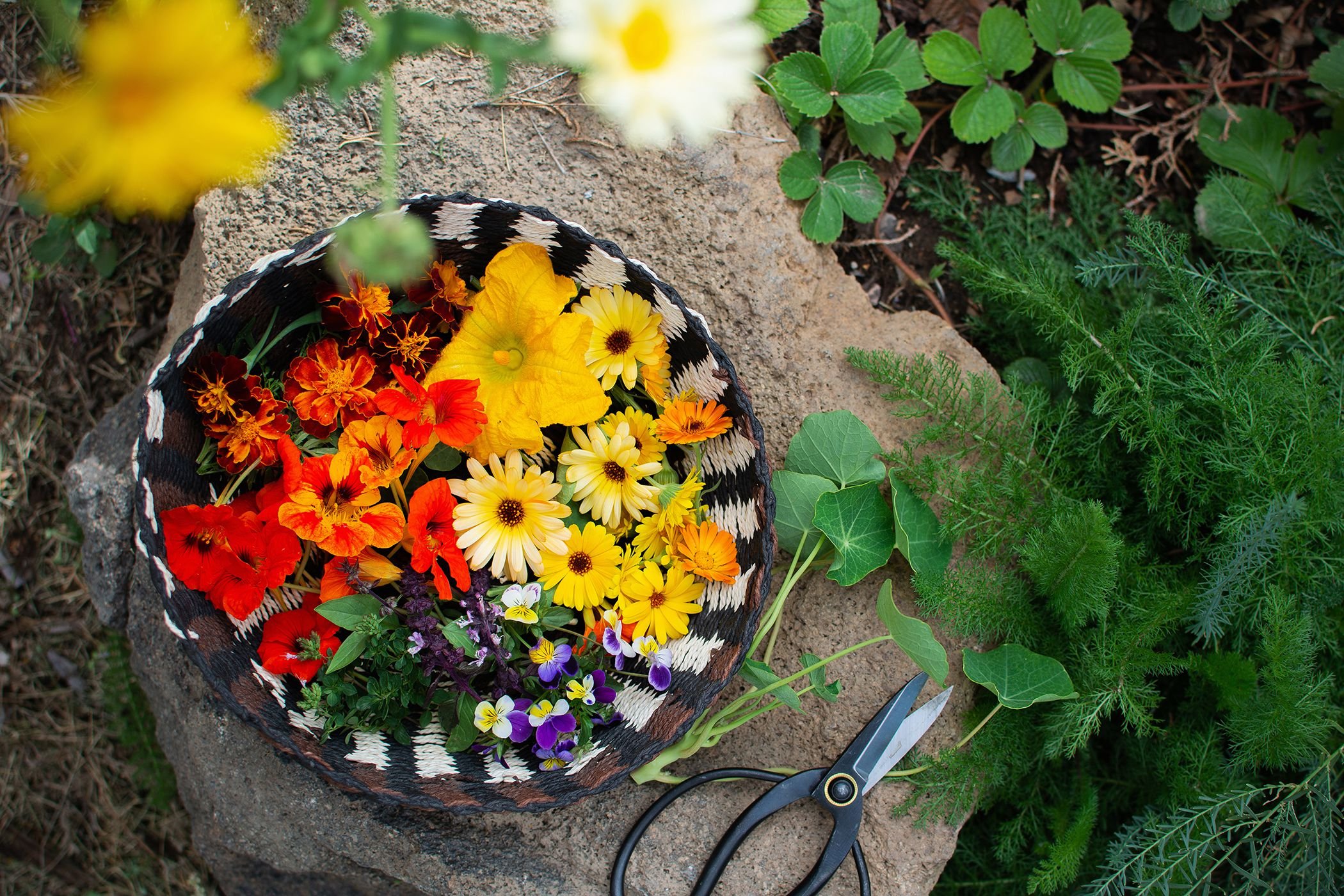Edible Flowers – they are not just another pretty face!
Monthly Theme: Edible Flowers – they are not just another pretty face!
You might be pleasantly surprised to learn how many edible flowers you have growing in your own yard right now. In fact, while researching this topic, I discovered there are so many more edible flowers then I previously realized. Since the list is too long to go into detail about each edible plant, I’ve selected ten to discuss and provided you a list of additional edible plants to explore on your own. I’m sure this list doesn’t include all of the edible flowers, but it’s a good start. I didn’t include edible herbs (almost every herb is edible), veggies (like squash or broad bean flowers), trees (like eating cherry or citrus tree blossoms) or weeds (such as dandelion or clover) - that’s a whole other blog! Plus, I’m focusing on edible flowers that grow in Northeastern Ohio.
Eating flowers is not that far-fetched of an idea. In reality, we are already eating plant flowers whenever we eat cauliflower, broccoli or artichokes. These are really the flower buds of the vegetable plant. In fact, throughout history eating certain flowers has come in and out of style. For centuries, Cherokee people have been eating coneflowers and other edible flowers. I guess there really is nothing new under the sun – just remarketing in a new package.
I’ll confess that I went outside at lunchtime to taste a Daylily (Hemerocallis spp.) and it was great! However, be careful that you are sampling a Daylily and not a True Lily (Lilium spp.) because those are poisonous! Know your plants.
Let’s start with Nasturtium (Tropaeolum) because most people are probably aware that it is edible. I’ve grown Nasturtium for years and it usually reseeds itself and comes back on its own. The entire plant is edible; however, generally people just eat the flowers. They have a peppery, mustard-like or watercress taste. They look beautiful on top of cakes, in salads or you can freeze them in ice cubes to elevate your iced beverages.
Second choice, Bachelor’s Buttons (Centaurea cyanus) offering a slight cucumber taste making them ideal for salads, but people also put them in bakery for a splash of cobalt blue color.
Third selection, Calendula (Calendula spp.) or Pot Marigolds have flowers that can be used for ornamental, culinary or medicinal purposes. It can be bitter so use sparingly. You can easily infuse oils with Calendula or better yet infuse them in gin for a floral note in your summer cocktail.
Fourth up, Tulips (Tulipa spp.). I’ve actually tasted these, but I so love the look of tulips, I just can’t imagine eating them instead appreciating their beauty. Tulips taste like a mix between peas and asparagus, which would work well in a veggie or egg dish.
Fifth on my list, Begonias. Wax Begonias (B. x semperflorens) and Tuberous Begonias (B. x tuberhybrida) are said to taste the best. I was astonished to learn that commonly grown Begonias are edible. Personally, I haven’t tried them, but I’ve read they taste like a Granny Smith apple or citrus fruit. So, they would go well with an apple dessert.
Onto number six, Anise Hyssop (Agastache foeniculum), which have a sweet, licorice-like flavor. The flowers or leaves can be used in soups, pasta or meat dishes. Basically, any dish that you would use Rosemary for would work with Hyssop. The flower heads are fuzzy so cut them up finely before using them in your recipe. Bonus – I love the smell of this plant when I walk past it in my yard!
Up next in seventh place Bougainvillea (Bougainvillea spp.). This one is for my daughter who lives in Florida and has a couple Bouganivillea’s growing in her yard. The brilliantly bright flowers are really bracts or colored leaves. The edible part is the bracts not the narrow flower in the center of the bract. If used in a tea, don’t steep long or they will turn from sweet to bitter. You can make a tasty agua fresca made with water, sugar, lime juice, and bougainvillea bracts.
Taking eight place Hibiscus (Hibiscus rosa-sinensis), which has a refreshingly tart flavor (think of Hibiscus or Jamaica tea). Chiefs use them quesadillas and enchiladas. They also work well in jams and jellies. Hibiscus is a good source of antioxidants and positive health benefits.
Filling my nineth spot, the Common Daisy (Bellis perennis). Daisies can be eaten from bud to withered petal. The buds are often pickled like capers or candied for desserts. The flowers work well in cottage cheese or spinach dip. WARNING: Shasta (Leucanthemum × superbum), Gerber (Gerbera spp.), and Montauk daisies (Nipponanthemum nipponicum) are not true daisies and these are not edible.
Last pick (pun intended!) Dahlia (Dahlia pinnata). Dahlias are relatives of Jerusalem artichokes and sunflowers. All species are edible, but some taste better than others. They taste similar to a water chestnut. In South America, Dahlia’s have been grown as a food crop. Try chopping some petals and adding them into salsa, a fish or rice dish – be inspired.
HINTS: All types of blossoms should be eaten fresh and avoid washing the flowers until you’re ready to use them. Also, make sure you are not picking flowers that have been sprayed with chemicals. Frankly, never eat anything unless you are positively sure you have identified it accurately.
Here's the edible flower list I promised you.
Acacia aka mimosa tree (Acacia dealbata)
Anise Hyssop (Agastache foeniculum)
Bachelor’s Buttons (Centaurea cyanus)
Bee Balm (Monarda didyma)
Begonia (Begonia genus)
Borage (Borago officinalis)
Bougainvillea (Bougainvillea spp.)
Calendula (Calendula spp.)
Carnation (Dianthus caryophyllus)
Chamomilla (Chamaemelum nobile)
Chrysanthemums (Chrysanthemum spp.)
Coneflowers (Echinacea spp.)
Cosmos (Cosmos sulphureus)
Dahlia (Dahlia pinnata)
Daisy’s (Bellis perennis)
Daylily (Hemerocallis spp.)
Elderflowers (Sambucus spp.)
Evening primrose (Oenothera biennis)
Forget-me-not (Myotis spp.)
Forsythia (Forsythia spp.)
Fuchsias (Fuchsia spp.)
Gardenias (Gardenia spp.)
Geraniums - scented (Pelargonium spp.)
Gladiolus (Gladiolus spp.)
Hibiscus (Hibiscus rosa-sinensis)
Hollyhocks (Alcea spp.)
Honeysuckle blossoms (Lonicera spp.)
Hosta (Hosta spp.)
Impatiens (Impatiens walleriana)
Jasmine - Arabian (Jasminum sambac)
Lavender (Lavandula spp.)
Lemon Verbena (Aloysia citradora)
Lilacs (Syringa spp.)
Lotus (Nelumbo spp.) and Water Lily (Nymphaeaceae family)
Mallow (Malva spp.)
Marigolds (Tagetes spp.)
Orchids (Dendrobium species)
Pansies (Viola tricolor var. hortensis)
Passionflowers (Passiflora spp.)
Peonies (Paeonia spp.)
Phlox – garden or fall (Phlox paniculata)
Primroses (Primula vulgaris)
Roses (Rosa spp.)
Snapdragons (Antirrhinum spp.)
Sunflowers (Helianthus annuus)
Sweet Alyssum (Lobularia maritima)
Sweet Williams (Dianthus barbatus)
Tulips (Tulipa spp.)
Violets (Viola spp.)
Yarrow (Achillea millefolium)
Yucca (Yucca bachata)
Zinnia (Zinnia elegans)
It’s exciting to see how many community gardens are popping up in my town and surrounding areas. Some of the community gardens are solely flowers, others herbs or vegetables. More and more vacant urban spaces are being reclaiming and utilized to bring beauty to the community or much needed food. I’ve seen several neighbors remove their entire front lawns and replace it with vegetable gardens.
On a bigger scale, instead of planting a crabapple tree, why not just plant an apple tree? In lieu of another non-native (and now banned in Ohio) Bradford Pear tree, plant a Bartlett Pear tree. Forget the Purple-leaf Plum tree and grow an edible American Plum tree. Wouldn’t it be great to having a thriving Bing Cherry or Scarlet Prince Peach tree producing fruit right in your own back yard? Consider planting blueberry, raspberry or blackberry bushes as borders instead of useless scrubs. Grapevines would make an excellent fence-like live border.
I hope I’ve convinced you to try edible flowers that might even be growing in your own back yard for eating, drinking, and cooking. They can be used for so many dishes and much more than just another pretty garnish (aka face). Be creative, use your imagination when adding flowers to a wide range of recipes – tantalizing teas, pickled delicacies, spiced vinegars, savory stir fries, unique syrups or cocktails, stunning salads, flavorful sandwiches, candied treats, compound butters, jellies, jams, and even steeped in wine. Really the skies the limit or at least the goal! Turn your kitchen into a Michelin star restaurant and wow your guests by allowing edible flowers to find a place on your plates and dining tables.


